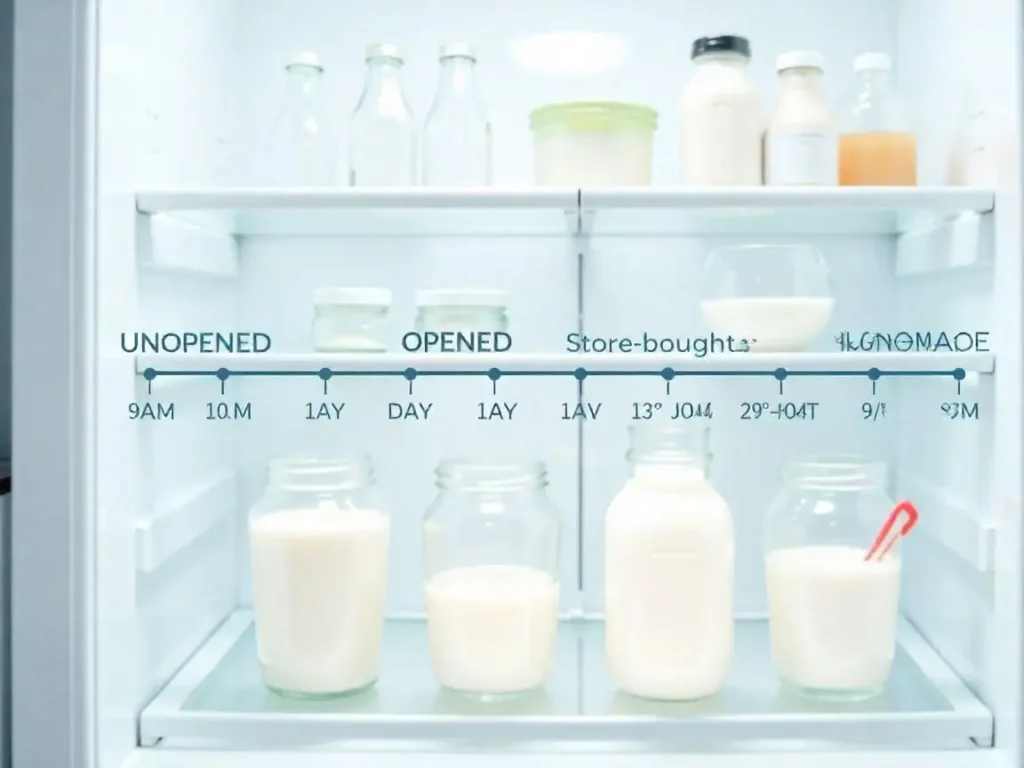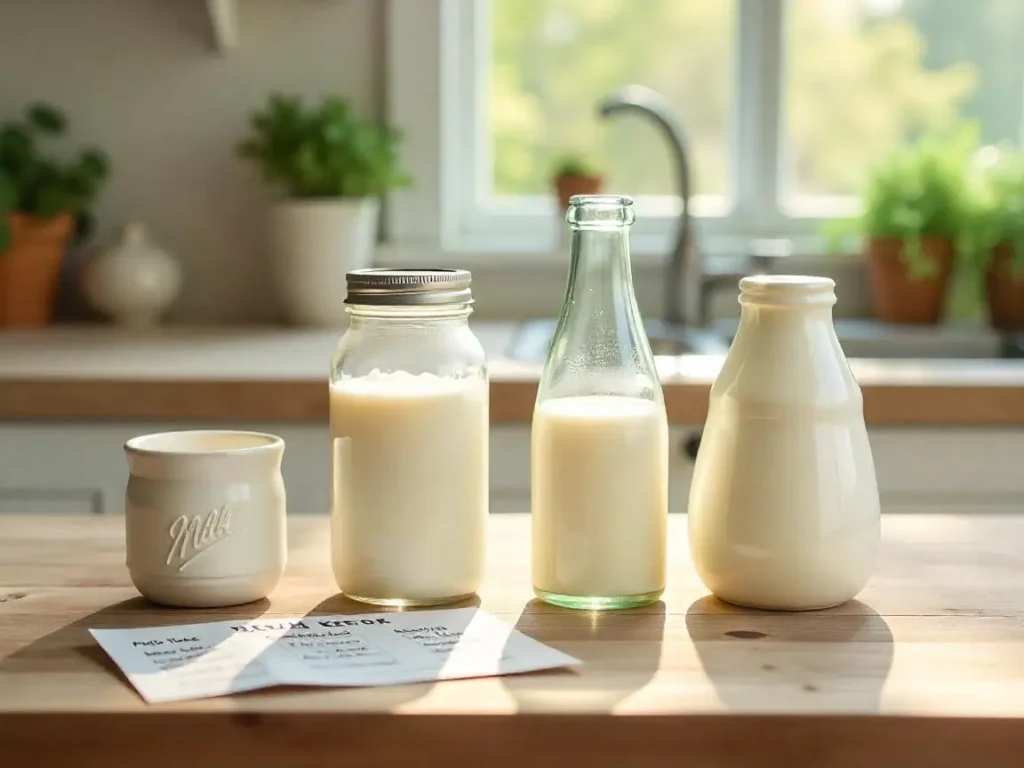Yes, kefir can definitely go bad despite being a fermented food product. As someone who’s been a purveyor of fermented milk beverages for over a decade, I can confirm that this cultured refreshment isn’t immortal! Kefir originated centuries ago in the Caucasus Mountains, where kefir grains were added to milk, triggering the fermentation process that creates this effervescent, tangy drink often compared to yogurt. While it resembles a drinkable yogurt, kefir offers remarkable probiotic benefits and health advantages including improved digestion and protection against bacterial infections, making it both satiating and nutritious.
Despite containing beneficial bacteria and offering potential health benefits, kefir’s longevity has limits. Unopened commercial-grade kefir typically lasts about a week past the sell-by date, but once you unscrew the lid, it’s a different ballgame – properly stored, opened kefir stays fresh for just up to five days. While it might be tempting to consume it beyond its lifespan, consuming spoiled milk beverages facilitates food poisoning. To maximize the quality and freshness of this delicious, probiotic-rich beverage, focus on proper storage techniques in your kitchen refrigerator (not a secondary cooling unit in your basement). Factors affecting flavor and nutritional value include temperature, exposure to light, and container material. Some best practices for storing kefir and preserving kefir include tight sealing after the container opened, consideration of alternative preservation methods like freezing, and careful handling of these high-quality products. Enjoy the health-promoting properties of kefir, but always plan kefir consumption around its expiration for lifespan extension of this beneficial fermented milk beverage with tangy taste.
Table of Contents
How Long Does Kefir Last? (Shelf Life Overview)
I’ve been a purveyor of homemade and store-bought kefir for years, so I know that this fermented milk beverage can be delicious and nutritious, but it doesn’t last forever. When you unscrew the lid on that bottle, the countdown starts: opened kefir lasts about up to five days in the refrigerator if properly stored, though some drink manufacturers insist it’s good until the sell‑by date printed on the carton. An unopened commercial‑grade kefir keeps about a week past that date, sometimes even 1–2 months if you stash it in the coldest part of your kitchen refrigerator or a secondary cooling unit in the basement. I once left a jar of homemade kefir in the fridge door and it turned tangy beyond enjoyment in just three days. A lesson learned: keep it in the back, where the temperature is steady.

Factors That Change Shelf Life
Several factors can degrade kefir faster: exposure to heat or light, improperly sealed containers, or frequent handling that lets new bacteria in. The live probiotics (sometimes as many as 60 different strains) keep the drink safe longer than plain milk, but they can’t prevent spoil forever. If you see large clumps, mold, or smell foul odors, it’s beyond its lifespan and consuming spoiled milk beverages only facilitates food poisoning. To maximize freshness and preserve those health‑promoting properties, consider alternative preservation methods like freezing for lifespan extension, then thaw in the fridge and stir gently to reincorporate the effervescent beneficial bacteria.
Signs of Spoiled Kefir: When to Toss It Out
When I first poured my kefir from the jug, I got a rude reminder that this probiotic-rich beverage can become spoiled kefir if you miss the telltale signs of rot. The moment I detected a rotten smell, an acrid odor and a sour smell that was more intense than the usual tangy scent or a cup of yogurt aroma, I knew the fresh kefir had turned into an ill-tasting beverage that could cause food poisoning if I kept drinking it. I saw curdling with lumps and bumps, excessive separation of milk liquids and solids, and even visible organic growth and moldy kefir, classic hallmarks of expiration and a key hallmark that should prompt you to replace kefir and throw it out immediately. Though it feels elementary, never taste kefir when unsure, because an expired kefir may bring stomach pain, vomiting, and other less-than-desirable symptoms that you’d avoid at all costs.

For safe eating, I now store every carton beverage at a steady 40 °F in the back of my fridge, a simple proper storage step that helps maximize how long kefir lasts in its shelf-life window. Occasionally I transform slightly tart kefir into a tangy sour cream substitute, but I always heed those indicators, once the smooth consistency, creamy consistency, or silky consistency gives way to any sign of rot, it’s time to replace kefir to keep enjoying a probiotic-rich beverage and maintain happy eating while also boosting my confidence in the know longevity of this fermented delight.
Proper Storage of Store‑Bought Kefir
I’ve found that keeping store-bought kefir at a steady chill is key. As soon as you bring it home, pop it into the back of your fridge where the temperature stays closest to 37°F/3°C, and always keep the lid sealed or transfer it into an airtight container if you’ve opened it. This prevents oxygen from speeding up spoilage and stops your kefir from picking up flavors from other foods. When I switch jars, I use a clean spoon and pour gently to avoid agitating the cultures. This little step helps avoid cross‑contamination and keeps the texture smooth.
In my experience, the biggest mistakes are storing kefir on the door shelf (where it warms up every time you open it) or using containers that aren’t fully sealed. I once lost a batch to mold because I left the lid loosely placed after a late‑night snack. To prevent that, always wipe the rim clean before closing and use only clean utensils when scooping out kefir. This simple routine makes sure your tangy, probiotic‑rich drink stays fresh and delicious right up until its sell‑by date and often several days beyond.
Storing Homemade Kefir Properly
When you make kefir at home, its shelf life can feel endless because your particular culture of bacteria and yeast is so robust, it’s fully comprised of good probiotics that fight off mold and spoilage bacteria, creating an acidic environment that will continue fighting spoilage bacteria and mold so it essentially won’t go bad for a very long time . In my kitchen, I’ve seen milk kefir best fresh within 0‑4 days for Best Tasting results, while water kefir better stored often develops multi‑dimensional flavors after 2‑10 days at 0‑3 °C in a glass airtight jar vs. plastic . I label each jar with its make date, keep them in the back of my kitchen refrigerator, and rotate batches so that recommendations for consumption 0‑4 days for milk, 2‑10 days for water are always clear.

I also treat Ginger Beer cultures (palatable until 1‑7 days, good until 2‑4 weeks) and Kombucha or Jun (fresh at 0‑14 days, palatable until 2‑4 weeks) the same way, swapping jars between a secondary cooling unit in the basement and the main fridge for lifespan extension . For Room temperature yogurts like Viili, Caspian, and Fil Mjolk, I use them within 0‑7 days (palatable to 1‑2 weeks) before they become too sour, which I’ve found keeps the probiotic-rich beverage enjoyable and safe.
Extended Shelf Life Techniques for Kefir
When you freeze kefir, the live cultures essentially enter dormancy, pausing active fermentation and slowing spoilage; this method can extend its usability from the typical refrigeration 2‑3 weeks to freezing 1‑2 months when sealed in an airtight container and clearly label freezing date on the lid. In my kitchen, I’ve found that freezing in small portions helps avoid texture alteration ice‑crystal formation is minimized when you thaw in the refrigerator rather than at room temperature or with heat. After thawing, a gentle stir before consuming brings back the creamy consistency and preserves probiotic content almost as well as fresh kefir, though some drop in viable bacteria is normal (around 15–50% over two months).

For best results, compare your storage method comparison by tasting batches stored under different conditions: I keep one batch in refrigeration 2‑3 weeks and another frozen; the frozen kefir reliably reactivates when thawed and still works great in smoothies and dressings. You can also use recipe incorporation like adding thawed kefir to pancake batter or salad dressings to mask any slight changes while getting maximum benefit If you’re preserving grains themselves, dry them briefly, then freeze; they can survive up to a year and will reactivate when thawed by simply placing them in fresh milk at room temperature.
Taste Changes Over Time: What to Expect
When you open a bottle of kefir and store it in the fridge, the live cultures in your finished drink stay active and continue to slowly ferment. Over time, this natural process makes kefir less sweet, more acidic, and even more alcoholic as the microbes eat up the sugars. With milk kefir, you’ll notice a greater activity and richer milk content in the first 48 hours, so it tastes fresh and creamy. After about 3–5 days, it shifts toward a sharper, tangy profile, still safe, but the flavor has moved beyond that optimal drinking window.

In my own kitchen, I’ve seen homemade water kefir held for a week develop multi‑dimensional flavors, fruity and complex, rather than simply sour. That extra tang isn’t spoilage; it’s just continued fermentation. You can enjoy that taste twist if you like bold flavors, but if it turns sharply pungent or develops off‑notes, that’s when sourness indicates actual spoilage rather than natural change.
Commercial vs. Homemade Kefir: Shelf Life Comparison
When you buy store‑bought kefir, it’s made in a controlled ferment with added stabilizers and often pasteurized milk. This means it can sit at or below 40°F in the fridge for 1–2 weeks without losing safety or quality . The refrigerator temperature is kept constant (about 37 degrees Fahrenheit) and the bottles are sealed tightly, so there’s less bacterial growth, mold, or spoilage even if you open them a few times . By contrast, homemade kefir is a symbiotic culture of bacteria and yeast (scoby) in milk; it lives in an air‑tight container like a mason jar or lidded food storage container, but as soon as you open it, room temperature air and new microbes can enter, so its degraded texture and degraded flavor show up faster .
I’ve found in my own kitchen that homemade kefir often tastes best within 0–4 days (milk kefir) or 2–10 days (water kefir) of refrigeration, after which it turns more acidic and even slightly alcoholic, though it technically won’t go bad for weeks thanks to its acidity fighting off spoilage bacteria . Store‑bought kefir, however, still tastes good up to its sell‑by date and sometimes 2–4 weeks afterward if unopened just check the expiration date printed on the carton and keep it in the back of your fridge where it’s coldest . If you ever spot mold, large clumps, or a rotten smell, discard immediately.
Creative Ways to Use Up Kefir Before It Expires
When kefir starts to show off-putting smells, texture changes, or a very sour taste, it may be spoiled. Drinking spoiled kefir comes with serious risks consuming expired kefir because harmful bacteria can grow, causing foodborne illnesses that lead to stomach discomfort, nausea, vomiting, and diarrhea. To avoid these problems, always check kefir carefully and consider disposal if you notice these signs.

Before kefir goes bad, there are many alternative uses to enjoy it. I often use kefir in smoothies or breakfast recipes for a healthy start to the day. It works well in cooking too, such as baking, making dressings, or marinades, where it can replace buttermilk or yogurt. Quick kefir-based dips and sauces add a tangy twist to meals, and it’s great in desserts and treats. Beyond the kitchen, kefir’s acidic properties make it a natural cleaning agent to remove soap scum and polish stainless steel. It also works as a gardening fertilizer that helps keep the soil’s pH balance. For skin care, kefir’s lactic acid can exfoliate and hydrate skin when used as a skincare face mask. If you want to share kefir with your pets, it can be a healthy pet probiotic treat, but always get a veterinarian consultation first. These ideas help me avoid waste and enjoy kefir fully before it expires.
Special Considerations for Different Kefir Types
Water kefir demands careful timing-while it stays fizzy and tangy for 2-10 days optimal in the fridge, I’ve pushed it to 3-4 weeks acceptable by using airtight bottles. Compare this to milk kefir storage specifics: its sourness sharpens after 0-4 days best taste, but remains safe for 1-2 weeks palatable if kept cold. Coconut kefir’s higher fat content requires stricter handling-once opened, its 7-day window demands daily checks for separation, a lesson I learned after losing a batch to unexpected mold.

Non-dairy kefir storage variations hinge on base ingredients; almond or oat versions often separate faster than dairy counterparts, requiring vigorous shaking before use. Don’t overlook the second fermentation impact on shelf life-adding fruit purees might boost flavor, but cut longevity by 2-3 days. My own experiments show unflavored second-fermented kefir lasts longer, though the probiotic boost makes the tradeoff worthwhile for gut health. Always prioritize smell over dates-if your coconut kefir smells like overripe pineapple, it’s time to compost it, not drink it.
Alternative Uses for Expired Kefir
When your kefir turns sour, don’t toss it-repurpose it. Dilute expired kefir with water for garden fertilizer applications; its probiotics enrich soil microbes, boosting plant health. I’ve seen neighbors revive struggling rose bushes by adding kefir to their watering cans. For composting options, mix it into your bin to accelerate decomposition-the lactic acid breaks down organic matter faster. In skincare and beauty treatments, apply it as a face mask; the lactic acid exfoliates gently. One friend swears by kefir hair treatments for shine. If considering pet care possibilities, check with your vet first-some approve small amounts for digestive support, but never risk it without professional advice. Even around the house, kefir’s acidity makes it useful for cleaning applications like polishing stainless steel or removing soap scum. Just avoid using it on porous surfaces where the smell might linger.

Years ago, I experimented with expired kefir to clean my tea kettle-surprisingly, it tackled mineral buildup better than vinegar! For gardeners, blending over-fermented kefir into compost adds beneficial bacteria, creating richer soil. Just remember: while kefir’s versatility shines in skincare and beauty treatments (think DIY foot soaks or cuticle softeners), patch-test first to avoid irritation. With pets, even a teaspoon of expired kefir mixed into food after vet approval can aid digestion, but never assume it’s safe for all animals. Whether you’re nurturing plants, pampering skin, or tackling household grime, that expired bottle holds hidden value-just think beyond the expiration date.
Conclusion
To keep your kefir fresh and safe, always store it tightly sealed in the back of your fridge at a steady, cold temperature-this simple habit helps you enjoy the best taste and texture for each kefir type, whether it’s milk, water, coconut, or non-dairy. Watch for signs like a strong sour smell, curdling, or mold, and use this quick guide: milk kefir is best within 0–4 days, water kefir 2–10 days, and coconut kefir within a week once opened. If you’re not ready to use it up, freezing is a great way to extend shelf life, and always remember to stir gently after thawing. I’ve learned that a little care goes a long way-so trust your senses, get creative with recipes before kefir expires, and enjoy all the health benefits this probiotic drink offers. If you’re curious, try new kefir recipes and discover just how versatile and delicious this fermented favorite can be then, join Kefir Guide for fresh tips, clever storage hacks, and delicious ways to enjoy kefir every day!
FAQs
Can Kefir Be Left Unrefrigerated?
Kefir should not be left out at room temperature for more than 2-3 hours, as warm conditions speed up spoilage and can make it unsafe to drink.
Does Kefir Need To Be Refrigerated Immediately After Purchase?
Yes, for the best taste and safety, put kefir in the fridge as soon as you get home; keeping it cold helps preserve its probiotics and freshness.
Is It Normal For Kefir To Separate In The Container?
Absolutely! Separation is normal-just give your kefir a good shake or stir before drinking to mix it back together.
Can I Consume Kefir After The Expiration Date?
If it smells fresh and tastes right, unopened kefir can sometimes be enjoyed up to a week past its date, but always check for sour odors, clumps, or mold-when in doubt, throw it out.
How Do Kefir Grains Affect Storage Duration?
Kefir made with live grains tends to stay fresh a bit longer because of the strong probiotic activity, but it still needs to be stored in the fridge and enjoyed within a week for the best flavor and safety.

Hi, I’m Natalia Smith, a kefir enthusiast and content writer dedicated to making fermented dairy approachable and enjoyable. My journey with kefir began in my own kitchen, experimenting with recipes and sharing the health benefits I discovered. Through hands-on experience and continuous learning, I aim to provide clear, trustworthy information that helps others embrace the goodness of kefir in their daily lives.
